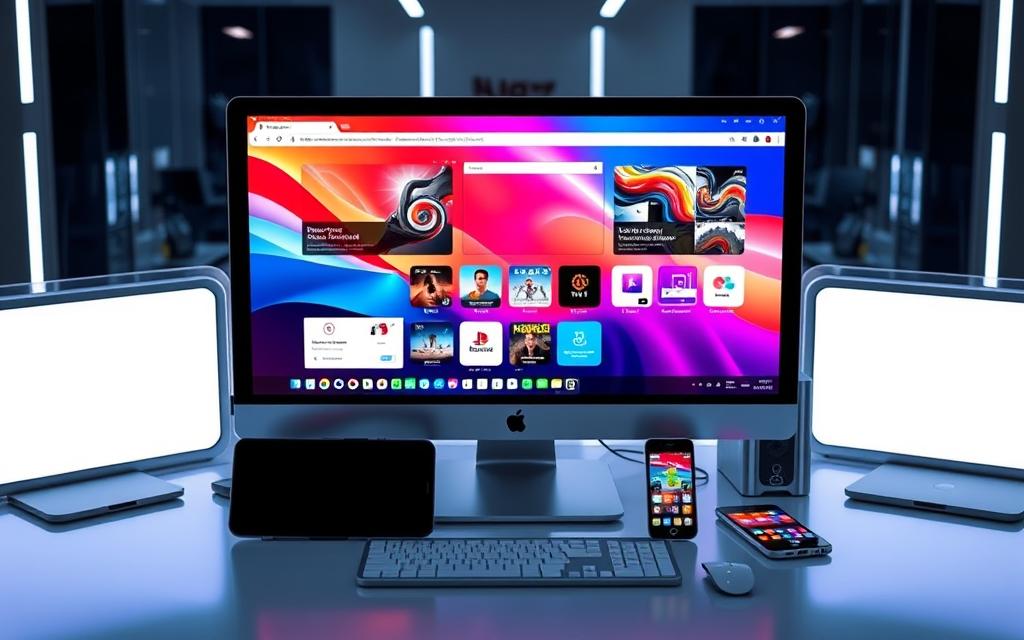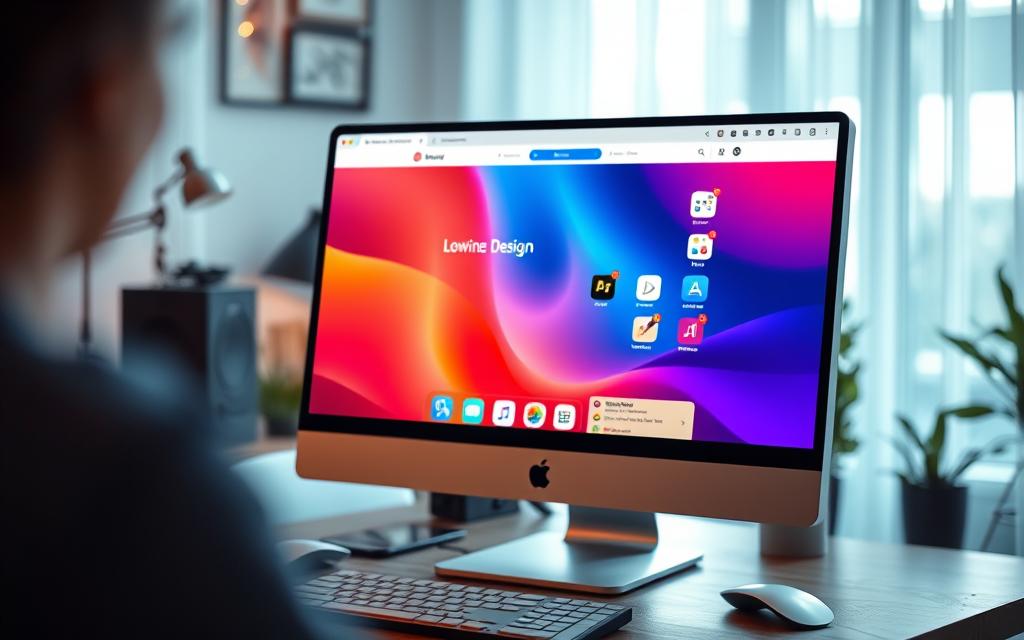Table of Contents
These days, more websites are mobile-first, making it key for users and developers to access them on PCs. There’s a big mix of devices and browsers out there. Knowing how to view mobile sites on a PC can make things much better for you. More people now prefer browsing on mobile, which shows how important it is to have good mobile browsing tricks.
This guide will show you different ways to view mobile websites better on your computer. With tools like Chrome DevTools, you can understand how mobile sites work. This makes surfing the web more enjoyable. Mobile sites are quicker to load and are cleaner and easier to use.
Understanding the Importance of Mobile Optimization
Nowadays, mobile optimization is vital. More people use mobile devices for browsing the internet. This makes it essential for businesses to offer great experiences on these smaller screens. Moving from computer to mobile designs is not just a trend. It’s a must-do for companies wanting to keep users interested.
The Rise of Mobile-First Design
The move to mobile-first design is because over 60% of web traffic now comes from mobile devices. This method makes the mobile experience a top priority in web design. It makes websites easy to use and look good on phones and tablets. Google supports mobile-friendly websites too. It ranks sites based on their mobile versions. With responsive design, websites can adjust to any screen size, keeping visitors on the page.
Impact on User Experience and Engagement
Good mobile design has a big impact on how people view websites. A site that loads in one second can triple its conversion rates compared to one that takes five seconds. If a site is slow, people will leave if it doesn’t load in three seconds. Mobile optimization is not just about quick loading. It also means making sites easy to navigate and read. Using the right font sizes and compressing images well can boost user involvement.
For more tips on improving your mobile user experience, read about optimising your site for mobile. Making your site work well on mobile is key to attracting and keeping viewers now and in the future.
How to Open Mobile Only Sites on PC
Accessing mobile-only sites on a PC can make browsing better and easier. There are two main ways to do this: using browser developer tools and simulating mobile devices in Chrome. These methods let you see how mobile versions of websites work. This gives you a more real experience when browsing.
Utilising Browser Developer Tools
Chrome’s browser developer tools let you switch between mobile and desktop views easily. This helps you see how content looks different on various devices. To use these tools, just right-click on a webpage and choose “Inspect”. Then, click the device toggle icon to view the mobile version.This technique effectively opens mobile sites on a PC, showing how they appear to mobile users.
Simulating Mobile Devices with Chrome
For a deeper dive, Chrome’s mobile simulation feature mimics different mobile devices. You can choose different device profiles to see how web content changes on various screens. This is vital as more than half of web traffic now comes from mobile devices. Seeing how sites respond to different screen sizes helps developers make better designs.
https://www.youtube.com/watch?v=fh4hO29Lt9Y
| Chrome Extension | Average Rating | Total Ratings |
|---|---|---|
| Mobile View Switcher | 3.5 | 106 |
| Responsive Viewer | 4.3 | 299 |
| Mobile Simulator – Responsive Testing Tool | 4.9 | 3.1K |
| Automate Your Bing Searches | 3.4 | 293 |
| Global Mobile | 5.0 | 6 |
| Mobile Browser Simulator UserAgent Switcher | 1.9 | 23 |
By using these methods, you can open mobile sites on a PC well. This ensures that web apps are tested well across devices. Doing this can boost a business’s credibility, as many people judge companies by their website design.
Using Chrome DevTools for Mobile Browsing
Chrome DevTools is a key tool for developers and web designers to make sites better for mobile use. It helps simulate mobile environments, making websites work well on phones and tablets.
Steps to Enable Mobile View
Starting mobile view in Chrome DevTools is easy. Just follow these steps:
- Open Chrome and go to the website you want to check.
- Right-click on the page, then choose Inspect to open DevTools.
- Press the Toggle device toolbar button or press Ctrl + Shift + M on your keyboard.
- Pick a device from the list or add your own mobile device settings.
Adjusting Screen Sizes and Resolutions
Once the device toolbar is on, you can change screen sizes and resolutions. This tool lets you simulate different devices for the best testing. Users can:
- Use preset sizes for common devices like smartphones and tablets.
- Adjust the device pixel ratio (DPR) to see CSS pixels correctly on the screen.
- Look at media queries to see how the site changes with different screen sizes.
- Try out sensor features for geolocation and how the device tilts.
This makes sure websites look great in mobile view, giving all users a top experience, no matter their device.
Exploring Browser Options for Mobile Access
The shift towards mobile devices has changed how we access the web. It’s vital to choose the right options for mobile browsing. This ensures websites work well on phones, especially for online shops. Blisk offers great tools for developers to test and preview sites efficiently.
Advantages of Using Blisk for Development
Blisk lets developers check how sites look on different devices all at once. This is because it can simulate multiple devices simultaneously. It’s good for spot-checking website appearances across various browsers. Some benefits of Blisk are:
- Dual view for comparing designs side by side
- Automated screenshots for quick feedback
- Integration with development tools for seamless workflow
Blisk helps make websites that automatically adjust for phone users. This is important because almost 60 percent of web traffic now comes from mobiles, says Statista.
Other Recommended Browsers and Their Features
Besides Blisk, there are more browsers good for mobile site work. They have unique browser features that make mobile sites better. Here’s a list of some:
| Browser | Key Features |
|---|---|
| Google Chrome | Device emulation, user-agent switching, and built-in DevTools |
| Safari | Responsive design mode and seamless integration with iOS devices |
| Firefox | Mobile view switching and extensive add-ons for development |
| Edge | Built-in mobile simulator for testing across Windows devices |
Using tools like these is key for creating sites that work well on phones. Today’s users often browse the internet on their smartphones. For more tips on making websites mobile-friendly, check out this guide on mobile site testing methods.

Testing Mobile Versions of Websites
Testing mobile versions of websites is vital to make sure they work well on different devices. Emulators can show how a site might look on mobile, but they’re not always accurate. For the best user experience, testing on real devices is key. It lets developers see how the site actually performs.
Why Real Device Testing is Essential
Real device testing gives a true picture of how mobile users see websites. It considers the vast range of devices, screen sizes, and OS versions out there. With an expected 7.5 billion smartphone users by 2027, it’s vital to understand their habits. People look at their phones about 58 times a day and use them for over 3 hours. These facts underline the importance of real-world testing.
Using BrowserStack for Robust Testing
BrowserStack is a great tool for real device testing. It gives developers access to many devices and browsers. This helps find issues that simulators might not catch. With BrowserStack, you can make sure websites work well on all devices, offering a smooth experience. Testing on real devices also helps understand performance, important for keeping users happy.
| Feature | Emulator | Real Device Testing |
|---|---|---|
| Accuracy | Moderate | High |
| Performance Metrics | Limited | Comprehensive |
| User Interaction | Simulated | Real-time |
| Device Variety | Fixed | Extensive |
Common Issues When Accessing Mobile Websites
Trying to get on mobile sites can be tough. You might face issues like things not responding or the site not fitting your screen right. Knowing these problems is key to fixing them.
Identifying and Troubleshooting Mobile Errors
Dealing with mobile site issues requires a step-by-step approach. Follow these steps to sort out many problems:
- Refresh the mobile page to ensure that the latest content loads.
- Clear the browser cache to remove outdated files that may interfere with loading.
- Check for modified HOSTS files that might redirect your access inadvertently.
- Temporarily disable local antivirus programmes, which can sometimes block content.
- Verify DNS settings for potential misconfigurations affecting your mobile browsing.
Trying the above steps can make mobile sites work better on a PC.
Ensuring Compatibility and Functionality
For the best mobile web experience, sites must work well on all devices. They should be easy to use on phones and computers. To keep things smooth, you should:
- Regularly test functionality across different systems to ensure consistent performance.
- Monitor system time clocks, as discrepancies can affect website loading.
- Assess network settings, including proxies and firewalls, for any restrictions on access.
- Consider running traceroute comparisons to diagnose network communication issues.
Making sure mobile sites work well and are compatible means a better experience for everyone. This lets users have a more dependable and functional time online, especially on PCs.
The Role of Responsive Design in Mobile Access
Responsive design is key in modern web development. It helps websites adjust automatically to any device or screen size. This approach guarantees that users have a smooth experience, whether they’re on a smartphone or a desktop. Roughly 54% of web traffic comes from mobile devices. This highlights how crucial responsive design is.
Leading companies now focus on a mobile-first strategy. This strategy is in response to the increasing need for better mobile access. Google has led with efforts like AMP and mobile-first indexing. These initiatives aim to boost mobile site performance and search rankings. Businesses such as Dropbox and BBC have seen improvements in user engagement after adopting mobile-first designs.
Flipkart and Airbnb have also seen growth from focusing on mobile users. Their responsive designs have boosted mobile transactions and bookings. These success stories show that prioritising mobile access can improve user engagement and satisfaction.
To make the most of responsive design, developers need to use flexible grids and media queries. These tools help content adapt to different screen sizes and orientations. Designers must also focus on usability. For example, making sure touch targets are at least 44 pixels square makes it easier for mobile users to interact with the site.
As mobile usage grows—now over 60% worldwide—responsive design is more important than ever. Web developers need to follow mobile-first principles. This is key to meeting the changing needs of users. It ensures that everyone has a positive experience on any platform.
Conclusion
As mobile browsing grows, it’s vital to know how to view mobile sites on PCs. We’ve looked at using tools like Chrome DevTools and the importance of testing on real devices. These techniques help make sure websites work well on all sorts of devices.
With mobile users expected to hit 7.7 billion by 2028, making websites that adapt to any screen is key. Responsive sites ensure everyone has the same great experience, regardless of device. They might cost more to make but are worth it for their consistent performance. Yet, for complex tasks, responsive designs on small screens can be challenging.
In wrapping up, following the discussed strategies boosts the mobile browsing experience for both users and developers. It matters whether you’re exploring mobile-specific sites or using adaptive designs. The goal is to keep sites easy to use and quick to load. Applying these tips will enhance access and make users happier in our mobile-first world.
FAQ
How can I access mobile-only websites from my PC?
You can visit mobile-only sites on your PC using browser tools like those in Chrome. These tools let you pretend you’re on a mobile device. Just turn on the mobile view in the developer tools to check the site on various screens.
What is mobile optimisation and why is it important?
Mobile optimisation makes sure websites work well on mobiles. It’s key because lots of web visitors use mobiles. With good optimisation, websites load faster, keep users happy, and make brands look better.
What are the steps to use Chrome DevTools for accessing mobile sites?
To use Chrome DevTools, first, go to the site you want to see. Right-click and pick ‘Inspect’ or press Ctrl+Shift+I (Cmd+Option+I on Mac). Then, hit the device toolbar button to see the mobile view. Now, you can try out different screen sizes.
Are there alternative browsers I can use to access mobile sites?
Yes, you can try other browsers like Blisk for checking websites on mobiles and PCs at the same time. Many browsers let you change settings to mimic mobile browsing, which can improve your experience.
Why is testing mobile websites on actual devices important?
Testing on real devices matters because simulators might miss specific user experiences or hardware features. Using tools like BrowserStack helps developers test on many real devices and browsers. This ensures websites run smoothly and work well for everyone.
What common issues might I encounter when accessing mobile websites from a PC?
When visiting mobile sites on a PC, you might find things that don’t respond or look wrong. To fix this, try reloading the page, clearing your browser’s cache, or checking the site on different devices. Doing so can make browsing better.
What is responsive design and its significance in mobile access?
Responsive design is about making websites work on any screen, big or small. It changes the layout to fit the screen. This approach makes sure everything works right on mobiles, making websites easier to use on any device.









